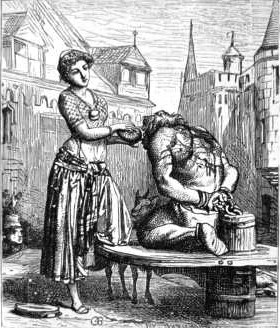
* * * *
I last posted on Palm Sunday, March 28. In that post I looked ahead to Easter Sunday, April 4. (See On “Zen in the Art of College Football,” featuring the thought at left.) This post will revisit the Sunday after Easter, to wit: The “Sunday of Many Names.”
You can see one original at On “Doubting Thomas Sunday” – 2017, which notes that today is known as: 1) The Second Sunday of Easter, 2) Low Sunday, 3) Doubting Thomas Sunday, 4) the “Octave of Easter,” and finally 5) “Quasimodo Sunday.” That last is from the Latin translation of First Peter 2:2, “Quasi modo geniti infantes,” as explained below.
For starters, today is officially the Second Sunday of Easter. Note the “of,” rather than “after.” That’s because Easter is “not just one day, but an entire season.” It’s a full season of 50 days – called Eastertide, “spanning from Easter Sunday to Pentecost Sunday.”
But today is also known – and in many churches is better known – as Low Sunday. That’s mostly because church attendance falls off so drastically that first Sunday “after.” (Compared with the high attendance of Easter Day itself…)
But you can also – as noted – call this day the “Sunday of Many Names.” For example, it’s known as “Doubting Thomas Sunday” … because the Gospel lesson always tells the story of the disciple Thomas. (See e.g. John 20:19-31, “which recounts the story of Christ appearing to the Apostle Thomas in order to dispel the latter’s doubt about the Resurrection.” Which made him in essence the original – the prototype – “Doubting Thomas.”)

And today is known as the Octave of Easter. (In this case the Octave in question is the eight-day period “in Eastertide that starts on Easter Sunday and runs until the Sunday following Easter.”) And finally, it’s known as “Quasimodo Sunday.” But that’s not because of Quasimodo, the guy – shown at right – who is better known as the “Hunchback of Notre Dame:”
That name comes from the Latin translation of the beginning of First Peter 2:2. (A traditional “introit” used in churches this day.) First Peter 2:2 begins – in English and depending on the translation – “As newborn babes, desire the rational milk without guile…” (Or translated as, “pure spiritual milk, so that by it you may grow up in your salvation.”) But in Latin the verse reads: “Quasi modo geniti infantes…” Literally, “quasi modo means ‘as if in [this] manner.’”
So, since “geniti” translates as “newborn” and the translation of “infantes” seems self-evident, the “quasi modo” in question roughly translates, “As if in the manner” (of newborn babes)…
The Coffman Commentaries on the Bible provides some background on this verse. in the King James version the verse reads, “as newborn babes, long for the spiritual milk which is without guile, that ye may grow thereby unto salvation:”
Paul used this same figure in 1 Corinthians 3:2; but Peter here, using the same figure, stresses, not the contrasting diet of infants and adults, but the appetite which all Christians should have in order to grow. All Christians should have a constant and intense longing for the word of God.
Which is pretty much the main theme of this blog: That all true Christians should have a strong “appetite in order to grow.” And a point which Paul seemed to be making in 1st Corinthians 3:2, “I gave you milk, not solid food, for you were not yet ready for it. Indeed, you are still not ready.”
But some people, it seems, are content to remain “babes in Christ.” Or boot-camp Christians, like those “Biblical literalists who never go ‘beyond the fundamentals.’” But how else – you may ask – are we to do “greater miracles than Jesus,” as mandated by John 14:12?
Like that Apostle, “Doubting Thomas,” who ended up making his own “passage to India.” See for example, Doubting Thomas’ “passage to India.” That April 2015 post noted the tradition that Thomas sailed to India in 52 AD, to spread the Christian faith, with details of his martyrdom:
According to tradition, St. Thomas was killed in 72 AD [near] Mylapore near Chennai in India… This is the earliest known record of his martyrdom. Some Patristic literature state[s] that St. Thomas died a martyr, in east of Persia or in North India by the wounds of the four spears pierced into his body by the local soldiers.
One result? India, and especially the Malabar coast, still boasts a large native population calling themselves ‘Christians of St. Thomas,’” as memorialized by the stamp below. (Not bad for a “newborn in Christ” who had to overcome his substantial doubts…)
* * * *

* * * *
Attributions for the upper and lower images – as well as those in the main text – can be found in the “Doubting Thomas Sunday” – 2017 post, and the Wikipedia articles included therein. For example, the lower image is from Wikipedia on the Apostle Thomas.